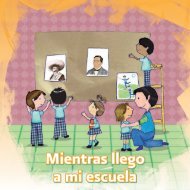Spanish for K-8 Heritage Speakers: A Standards-Based Curriculum ...
Spanish for K-8 Heritage Speakers: A Standards-Based Curriculum ...
Spanish for K-8 Heritage Speakers: A Standards-Based Curriculum ...
Create successful ePaper yourself
Turn your PDF publications into a flip-book with our unique Google optimized e-Paper software.
34 Hispania<br />
91 March 2008<br />
ask themselves: "What did I learn about my culture through my own family memories?"<br />
Finally, in sixth grade, students combine the theme of heroes and families yet once again. In<br />
first grade, students examined family heroes primarily because their lived experiences at that age<br />
do not extend far beyond the home. Now, in sixth grade, students will examine family heroes in<br />
order to reconnect with the familiar and avoid succumbing to the superficial, media-fed images<br />
that surround them of heroes <strong>for</strong> adolescents. Through reflection upon a dynamic, class-created,<br />
year-long-developed definition of the word "hero," students will examine whether they still<br />
think, five years later, that their family members are heroes in the scenario: "Familiar heroes:<br />
Family is important!" In this scenario, learners will travel through the entire writing process from<br />
pre-writing activities that use a picture book to ignite students' creative juices, to post-writing art<br />
activities. Students will listen to a read-aloud of Playing Loter?a/El Juego de la Loter?a by Ren?<br />
Colato La?nez and Jill Arenas, which depicts how a<br />
simple activity such as spending time with a<br />
family member can change one's life in a positive manner. Learners will determine whether or not<br />
the character of la abuelita was a hero in the little boy's life. Participants will then identify a<br />
Hispanic person in their families or community who is a hero to them, and explain in a pre-writing<br />
activity why that person is a hero. Next, the teacher will teach students how to use an outline to<br />
organize their ideas. After learners sketch an outline, they will create a rough draft, peer-edit that<br />
rough draft with the support of teachers, and proceed to a final draft. Finally, students will create<br />
a portrait of their Hispanic "familiar" heroes.<br />
While all three of these scenarios touched on families, heroes, and sometimes both, they<br />
certainly were not repetitions of each other. Each scenario sought to rein<strong>for</strong>ce existing skills, help<br />
students make connections with prior and background knowledge, as well as build upon this<br />
knowledge in order to generate new knowledge appropriate <strong>for</strong> that grade level. While the first<br />
grade scenario sought to introduce students to letter-sound development in order to aid stu<br />
dents with their first encounters reading print, the fourth-grade scenario helped learners to<br />
consciously process family traditions often taken <strong>for</strong> granted and consider their importance to<br />
culture. Further on, sixth-graders revisited the same themes but through writing an expository es<br />
say, a skill that will become increasingly useful as students proceed to high school. Even though<br />
the curriculum's structure is a vertical spiral thematically and linguistically from kindergarten<br />
through eighth grade, as stated be<strong>for</strong>e, it is not necessary <strong>for</strong> teachers to follow the curriculum<br />
from start to finish. The scenarios are kernels themselves, and can serve individual teachers just<br />
as well as adopting the curriculum school-wide. The scenarios have been developed in order to<br />
be tailored to individual needs.<br />
5. Concluding Remarks<br />
A well-designed K-8 <strong>Spanish</strong> <strong>for</strong> heritage speakers curriculum has exciting ramifications. It<br />
offers great potential <strong>for</strong> the development and maintenance of heritage speakers' <strong>Spanish</strong> during<br />
their early schooling years, the period which many researchers argue is most beneficial <strong>for</strong> lan<br />
guage learning. The literacy and content development promoted by this curriculum is expected to<br />
transfer to students' English literacy as well as to their overall academic skills (Briboisl995;<br />
Escamilla 1993 ; Garcia and Padilla 1985 ; Hulstij in 1991 ). A third idea that is supported by research<br />
findings is that a well-executed K-8 SNS curriculum may increase the high-school graduation rate<br />
of Hispanic students. Ramirez et al. ( 1991 ) and Thomas and Collier (2002) showed that native-lan<br />
guage-maintenance programs resulted in greater academic growth than did early exit programs<br />
and ESL-only programs, in which students finished well below national norms. In addition, this<br />
curriculum contains specific language-based experiences that aim to prepare students to succeed<br />
on Advanced Placement <strong>Spanish</strong> Language and Literature exams, which grant college credit and<br />
may serve as an incentive to completing high school. Future research that follows these children<br />
into high school may bear out this prediction. In fact, a curricular SNS articulation with high<br />
schools would be a welcome next<br />
step.<br />
In addition to FLES programs, teachers in bilingual-education programs with a native-Ian



